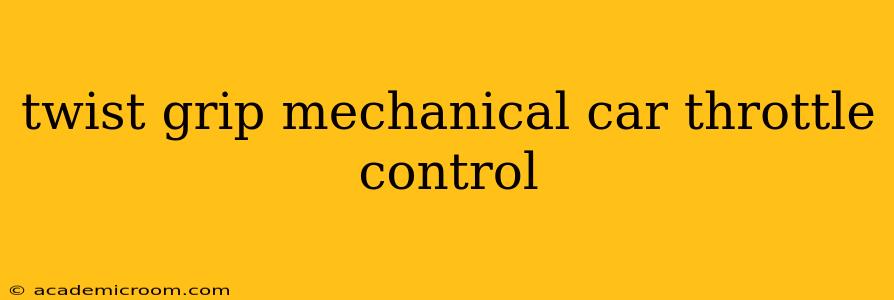For decades, motorcycle riders have enjoyed the intuitive control offered by a twist grip throttle. Now, this technology is finding its way into the automotive world, albeit in a niche market. A twist grip mechanical car throttle control offers a unique driving experience, and this guide will explore its advantages, disadvantages, and applications. We'll also delve into frequently asked questions surrounding this specialized automotive modification.
What is a Twist Grip Mechanical Car Throttle Control?
A twist grip mechanical car throttle control replaces the traditional push-pull pedal mechanism with a rotary grip, typically mounted on the steering wheel or a custom-designed location. This allows drivers to control engine speed by twisting the grip, similar to a motorcycle throttle. The mechanical aspect means it directly interacts with the throttle cable, offering a direct and responsive feel. This is distinct from electronic throttle controls which use sensors and actuators.
How Does a Twist Grip Mechanical Car Throttle Control Work?
The system works by replacing the traditional accelerator pedal with a rotary control. This control is mechanically linked to the throttle cable, which in turn operates the throttle plate in the engine's intake manifold. Turning the grip clockwise increases the throttle opening, increasing engine speed. Conversely, twisting it counter-clockwise reduces the throttle opening, slowing the engine. The simplicity of this design ensures a direct and responsive feel, eliminating the lag sometimes associated with electronic systems.
What are the Advantages of a Twist Grip Mechanical Car Throttle Control?
-
Improved Ergonomics: For drivers with mobility issues or those who find the traditional pedal setup uncomfortable, a twist grip can provide a more ergonomic and less fatiguing driving experience. This is particularly useful in situations involving extended driving periods or specific physical limitations.
-
Enhanced Control and Precision: The rotary nature of the control can offer a more precise and nuanced level of throttle control, beneficial in situations requiring delicate throttle inputs, such as off-road driving or navigating challenging terrain.
-
Increased Driver Focus: Some drivers find that a twist grip system allows for greater focus on other driving tasks, as they don't need to move their foot between the brake and accelerator pedals. This is particularly advantageous in racing or other demanding driving scenarios.
What are the Disadvantages of a Twist Grip Mechanical Car Throttle Control?
-
Safety Concerns: The most significant disadvantage is the potential safety risk. Improper installation or use could lead to unintended acceleration or loss of control. This is particularly true if the installation isn't conducted by a qualified mechanic.
-
Legal Restrictions: The legality of using a twist grip throttle system varies widely depending on location and vehicle type. Some jurisdictions may consider it an unauthorized modification, leading to legal complications and potential fines. Always check your local laws and regulations before installing this type of system.
-
Limited Availability and Customization: These systems are not widely available as aftermarket modifications and may require custom fabrication or modification to fit specific vehicles. Finding a qualified installer might also be challenging.
Is a Twist Grip Throttle Legal?
The legality of a twist grip throttle control varies significantly by region and even by specific vehicle type and intended use. Some jurisdictions may prohibit it outright, while others may allow it with specific modifications and inspections. Checking local motor vehicle regulations and consulting with a legal professional is crucial before installing such a system.
How Difficult is it to Install a Twist Grip Mechanical Car Throttle Control?
Installation is generally considered difficult and should only be undertaken by individuals with significant mechanical experience. Improper installation can compromise safety and potentially lead to vehicle malfunction or damage. It often necessitates modifications to the vehicle's existing throttle system and may require professional expertise to ensure safe and reliable operation.
What Vehicles are Compatible with a Twist Grip Mechanical Car Throttle Control?
Compatibility depends heavily on the specific design of the twist grip system and the vehicle's throttle mechanism. Generally, older vehicles with cable-operated throttle systems are more easily adaptable. Modern vehicles with electronic throttle control (drive-by-wire) are significantly more challenging, if not impossible, to retrofit with a mechanical twist grip.
Conclusion:
A twist grip mechanical car throttle control offers a unique driving experience with potential advantages for specific drivers and applications. However, it's crucial to weigh the potential risks, legal implications, and practical considerations before installing such a system. Always prioritize safety and legality, and seek professional advice when modifying a vehicle's control systems. The ease of installation and compatibility vary significantly, demanding careful research and potentially custom fabrication.
